

Aryan. "Aryan" ()[1] has as its root a term that was used as a self-designation by Indo-Iranian people.
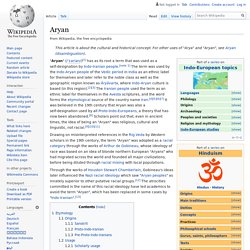
The Vedic sacrifice, soma sacrifice, & origins of Indian philosophical concepts. Copyright © 2003, 2004 by Lawrence C.
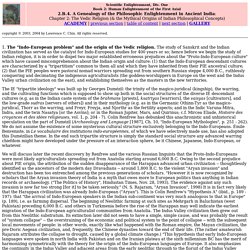
Chin. All rights reserved. 1. The "Indo-European problem" and the origin of the Vedic religion. Vedic Rituals and Sacrifices, Srauta Yajnas. By Jayaram V This is a comprehensive manual on Vedic rituals as practiced in ancient times, useful for both general and academic purposes.

It is a work in progress, and may require further additions, references and alterations. Jayaram V Hinduism has a ritual dimension which dates back to the Vedic times (2500 BC) or earlier. Soma. Soma may also refer to:

Soma sacrifice. Hinduism. Aryan race. Etymology The earliest epigraphically attested reference to the word "Aryan" occurs in the 6th-century BC Behistun inscription, which describes itself to have been composed "in Aryan (arya) [language or script]" (§ 70).
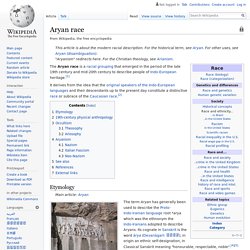
The "Aryan" in this context means "Iranian".[3] The term Aryan has generally been used to describe the Proto-Indo-Iranian language root *arya which was the ethnonym the Indo-Iranians adopted to describe Aryans. Its cognate in Sanskrit is the word ārya (Devanāgarī: आर्य), in origin an ethnic self-designation, in Classical Sanskrit meaning "honourable, respectable, noble".[4][5] The Old Persian cognate ariya- (Old Persian cuneiform: 𐎠𐎼𐎡𐎹) is the ancestor of the modern name of Iran and ethnonym for the Iranian people.[6] In the 18th century, the most ancient known Indo-European languages were those of the ancient Indo-Iranians.
However, in a climate of burgeoning racism it proved difficult to maintain such nuanced distinctions. 19th-century physical anthropology Occultism. Dravidian people. Ethnic group Dravidian people or Dravidians are speakers of any of the Dravidian languages.
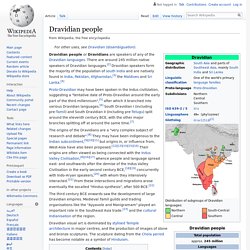
Upanishads. The Upanishads are a collection of texts of religious and philosophical nature, written in India probably between c. 800 BCE and c. 500 BCE, during a time when Indian society started to question the traditional Vedic religious order.

Some people during this time decided to engage in the pursuit of spiritual progress, living as ascetic hermits, rejecting ordinary material concerns and giving up family life. Some of their speculations and philosophy were compiled into the Upanishads. There is an attempt in these texts to shift the focus of religious life from external rites and sacrifices to internal spiritual quests in the search for answers. Etymologically, the name Upanishad is composed of the terms upa (near) and shad (to sit), meaning something like “sitting down near”. Brahmin. Varna (class) in Hinduism, one of four castes The traditional occupation of Brahmins was that of priesthood at the Hindu temples or at socio-religious ceremonies and rite of passage rituals such as solemnising a wedding with hymns and prayers.[2][3] Theoretically, the Brahmins were the highest ranking of the four social classes.[4] In practice, Indian texts suggest that Brahmins were agriculturalists, warriors, traders and have held a variety of other occupations in the Indian subcontinent.[3][5][4] Vedic sources a brahmin doing ahaman and chanting Myanmar Indonesia early 19th century India Purusha Sukta.
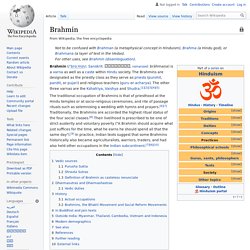
Devadasi. English[edit] Etymology[edit] From the Sanskrit देवदासी (devá-dāsī, “female servant of a deity”), from देव (devá, “deity, god”) and दासी (dāsī, “a female servant or slave”).

Noun[edit] devadasi (plural devadasis) (Hinduism) A girl that underwent Hindu religious practice in which they would be "married" to a deity. Related terms[edit] Nagarvadhu Further reading[edit] devadasi on Wikipedia.Wikipedia. Devadasi. A 1920s photograph of two Devadasis in Tamil Nadu, South India In South India, a devadasi is a girl "dedicated" to worship and service of a deity or a temple for the rest of her life.
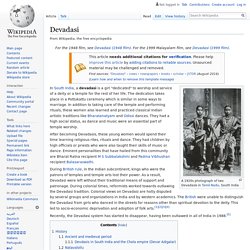
The dedication takes place in a Pottukattu ceremony which is similar in some ways to marriage. In addition to taking care of the temple and performing rituals, these women also learned and practiced classical Indian artistic traditions like Bharatanatyam and Odissi dances. They had a high social status, as dance and music were an essential part of temple worship. Bodhi Tree. Sacred fig tree in Buddhism Sculpture of the Buddha meditating under the Mahabodhi tree The Diamond throne or Vajrashila, where the Buddha sat under the Bodhi Tree in Bodh Gaya Coordinates: The Bodhi Tree (Sanskrit: बोधि), also known as Bo (from Sinhalese: Bo), "peepal tree", or "arasa maram" (Tamil:அரசமரம்)(Devanagari: पीपल क पेड़),[1] was a large and ancient sacred fig tree (Ficus religiosa[1][2]) located in Bodh Gaya, Bihar, India, under which Siddhartha Gautama, the spiritual teacher who became known as the Buddha, is said to have attained enlightenment or Bodhi.[3] In religious iconography, the Bodhi Tree is recognizable by its heart-shaped leaves, which are usually prominently displayed.
Nandi. From Wikipedia, the free encyclopedia Jump to navigationJump to search Nandi may refer to: Brahmana. Layer of Hindu text within the Vedas A 17th-century manuscript page of Sadvimsha Brahmana, a Pañcaviṃśa-Brāhmaṇa supplement (Sanskrit, Devanagari). Martin Buber. He was nominated for the Nobel Prize in Literature ten times, and Nobel Peace Prize seven times.[3] Biography[edit] Martin (Hebrew name: מָרְדֳּכַי, Mordechai) Buber was born in Vienna to an Orthodox Jewish family. Buber was a direct descendant of the 16th-century rabbi Meir Katzenellenbogen, known as the Maharam of Padua. Karl Marx is another notable relative.[4] After the divorce of his parents when he was three years old, he was raised by his grandfather in Lvov.[4] His grandfather, Solomon Buber, was a scholar of Midrash and Rabbinic Literature.
At home, Buber spoke Yiddish and German. Despite Buber's connection to the Davidic line as a descendant of Katzenellenbogen, a personal religious crisis led him to break with Jewish religious customs. Horace Hayman Wilson. Horace Hayman Wilson (26 September 1786 – 8 May 1860) was an English orientalist.[1] He studied medicine at St Thomas's Hospital, and went out to India in 1808 as assistant-surgeon on the Bengal establishment of the British East India Company. His knowledge of metallurgy caused him to be attached to the mint at Calcutta, where he was for a time associated with John Leyden. He was the first person to translate the Rigveda into English. Dharma. Forgiveness. Santosha. Santosha (skt. संतोष saṃtoṣa, santōṣḥ) literally means "contentment, satisfaction".[1][2] It is also an ethical concept in Indian philosophy,[3] particularly Yoga, where it is included as one of the Niyamas by Patanjali.[4] Niyama.
Niyama (Sanskrit: नियम) literally means positive duties or observances.[1] In Indian traditions, particularly Yoga, niyamas and its complement, Yamas, are recommended activities and habits for healthy living, spiritual enlightenment and liberated state of existence.[2] It has multiple meanings depending on context in Hinduism. Kama. Deity Kama whose arrows trigger desire. Dharma. Vayu Purana. Puranas. Significance of Guru Puja. Brihaspati Puja - Jupiter Brihaspati Puja, Thursday Fast and Puja. Brihaspati Puja - Jupiter Brihaspati Puja, Thursday Fast and Puja. Bṛhaspati. Vishnu. Vishnu's eternal and supreme abode beyond the material universe is called Vaikuntha, which is also known as Paramdhama, the realm of eternal bliss and happiness and the final or highest place for liberated souls who have attained Moksha.
Brahma. Chandogya Upanishad. Heinrich Zimmer. Heinrich zimmer. Indra.